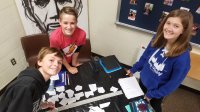Project Management for Middle School
How one middle school teacher guides his students to managing their project-based learning groups like pros.
I’m a middle school teacher who incorporates project-based learning whenever possible. Over the past four years, I came to understand that I was missing one of the key features necessary for a successful, high-quality, collaborative experience with middle school students: I had never provided my students a consistent structure to use when managing their projects. I realized I needed to teach them a specific language and process to ensure successful teamwork and clarity in expected deliverables.
Through my father-in-law, I learned about a project-management methodology used in the software world called Scrum. I adapted aspects of Scrum to create a classroom-wide project-management language that helps students iterate their products, set clear team expectations, and provide multiple opportunities for feedback and reflection along the way. Here’s how I did it.
Guiding Students to Iterate Their Projects
Overview: Using feedback to develop a project is one of the hallmarks of PBL. Scrum facilitates giving feedback by providing a simple set of terms to show students the level of prototype completion needed at each project checkpoint. These terms are cupcake, birthday cake, and wedding cake.
Application: At the beginning of each project, I provide students a list of required items to include in their finished product. I build in project checkpoints where they need to have successively more detailed versions of their projects ready for class feedback. For example, I initially ask students to complete the design thinking process and rapidly develop a “cupcake” or basic prototype of what a potential finished product might look like. Next, students complete a “birthday cake” prototype, which is expected to have half the required project elements and functionally stand on its own if needed. Finally, the “wedding cake” is the final product iteration that will be shared with an outside audience. When students turn in their prototypes, I have them participate in a gallery walk or Critical Friends Protocol for peer feedback.
Why It Works: The cake terminology has proven beneficial because students are easily able to visualize how complete each aspect of their project needs to be at each checkpoint, and to get feedback along the way. For instance, earlier this year I asked my students to identify a public policy issue they felt needed addressing, and, using the text of the Constitution or Bill of Rights as a guide, argue for how and why it could be solved. One student group chose to make a video on the impact of childhood hunger. They created a storyboard for their cupcake prototype, filmed half of their scenes for the birthday cake iteration, and completed the video for the wedding cake iteration, using feedback at each checkpoint to inform their future decisions.
Setting Clear Team Expectations
Overview: Trello is a free project management tool that has many useful capabilities, including integration with Google Drive, real-time collaboration, and accessibility via an application or a web browser.
Application: When starting a new project, each group creates a Trello board—a virtual bulletin board with cards for individual tasks—with three columns entitled To Do, Busy, and Done. In the To Do column, they create individual task cards with one project requirement per card. Using the point values for the tasks (which show the relative size of a task compared to other items that I assigned them on the project requirement list), students organize their teams around the work by attaching their names to a card, writing the estimated number of days needed to complete the task, and moving the task card into the Busy column. A student moves their card into the Done column when their task is completed. In our current National History Day project, task cards could include “analyze three primary sources” and “create the annotated bibliography.”
Why It Works: At the beginning of each work session, I ask student teams to open their Trello boards and review the group work they’ve completed since the last class session. My favorite part of these team meetings is when students recognize that a group member is struggling with a particular task, they will often assign themselves to the struggling student’s card to assist them.
Providing Opportunities for Team Reflection
Overview: I have long felt that two main strengths of well-run teams are their abilities to collectively reflect and communicate. So I decided to build in structured time for students to reflect at common checkpoints throughout a project.
Application: Every two weeks, I walk the students through a 20-minute structured reflection. The process requires students to generate a list of events or occurrences from the previous two weeks in their personal and academic lives that may have impacted their performance. Each event is placed on an individual Post-it note. Next, students combine their lists with those of their teammates and place all the Post-its in chronological order. Underneath, I place a wide piece of masking tape that runs the length of the Post-its. Each student chooses a different color and draws a continuous wavy line on the tape illustrating their stress level as it related to the project over the previous two weeks—the top of the tape indicates high stress and the bottom indicates low stress.
Why It Works: Students gain a greater understanding of how their personal and academic lives intersect and impact one another. Once these connections are made, students are able to better anticipate and respond to events that might impact their schoolwork, and they gain a greater understanding of each other’s lives.
